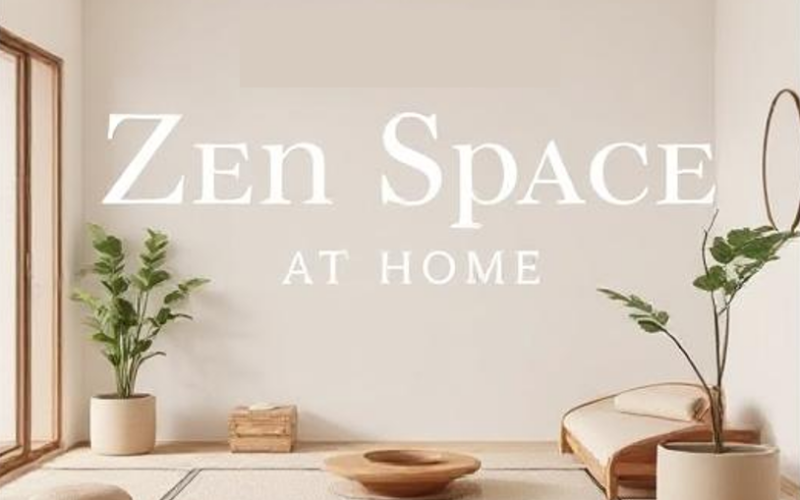Creating a Zen Space at Home

Introduction: The Power of a Zen Space at Home
In today’s fast-paced world, our homes should serve as sanctuaries where we can retreat, recharge, and restore inner peace. A Zen-inspired space offers tranquility, balance, and a deep connection to nature. Rooted in Japanese philosophy, Zen design emphasizes simplicity, harmony, and mindfulness, helping to reduce stress and promote well-being. In this guide, we’ll explore how to transform your home into a peaceful oasis that nurtures both the body and the mind.
What is Zen? Understanding the Philosophy Behind the Design
The concept of Zen originates from Japanese Buddhism and is closely associated with meditation, mindfulness, and simplicity. In interior design, it translates into a space that fosters relaxation, clarity, and serenity. Zen-inspired homes are free from clutter, incorporate natural elements, and promote balance between functionality and aesthetics.
Key principles of Zen design include:
- Minimalism: Eliminating excess to create a clean, open space.
- Balance and Harmony: Thoughtful arrangement of furniture and decor to promote peace.
- Natural Elements: Integration of wood, stone, water, and greenery.
- Neutral Colors: Soft, earthy tones that create a calming effect.
The Core Elements of a Zen-Inspired Home
1. Minimalism and Simplicity
A Zen home embraces the “less is more” philosophy. This means keeping furniture, decor, and personal items to a minimum while ensuring that everything serves a purpose.
How to achieve it:
- Use furniture with clean lines and neutral tones.
- Remove unnecessary decor and distractions.
- Organize belongings to maintain an open, breathable space.
2. Natural Elements: Wood, Water, and Greenery
Nature plays a vital role in Zen aesthetics. Incorporating natural materials fosters a sense of tranquility and grounding.
Suggestions:
- Use wooden furniture or bamboo flooring for warmth.
- Introduce indoor plants like bonsai, peace lilies, or bamboo.
- Add a small indoor fountain or aquarium to integrate water elements.
3. Soft Lighting and Serene Colors
Lighting and colors set the mood of a space. Zen interiors favor soft, diffused lighting and muted color palettes to enhance relaxation.
Recommendations:
- Choose warm white or yellow-toned lighting instead of harsh LED bulbs.
- Use sheer curtains to allow natural light to flow gently.
- Opt for neutral and earthy tones like beige, gray, or soft greens.
4. The Role of Scents and Sounds in Zen Atmosphere
Aromatherapy and calming sounds help to deepen the Zen experience.
Ideas:
- Use essential oils like lavender, sandalwood, or jasmine.
- Play ambient sounds like flowing water, Tibetan singing bowls, or nature recordings.
Decluttering: The First Step to Creating a Zen Space
Decluttering is essential to achieving a Zen aesthetic. A clutter-free environment allows for mental clarity and a sense of spaciousness.
Decluttering Tips:
- Follow the KonMari method by keeping only what sparks joy.
- Create hidden storage solutions to maintain a tidy space.
- Adopt a daily habit of organizing and putting things in their designated places.
Furniture and Layout: How to Arrange Your Space for Peace and Harmony
Choosing Zen-Inspired Furniture
Furniture should be simple, functional, and comfortable.
- Low-profile seating: Tatami mats, floor cushions, or low wooden furniture create a grounded feel.
- Uncluttered surfaces: Avoid excessive decorations and maintain clean tabletops.
- Natural fabrics: Linen, cotton, and wool add warmth and texture.
Arranging Your Space
A Zen layout promotes free movement and balance.
- Keep furniture away from pathways to maintain open spaces.
- Position seating near natural light sources for a refreshing ambiance.
- Introduce symmetry and balance in decor arrangements.
Zen Space for Different Lifestyles: Apartments vs. Homes
Small Apartments
For compact spaces, smart storage solutions and multi-functional furniture are key.
- Use foldable or minimalist furniture.
- Install floating shelves to maximize space.
- Utilize neutral tones to create an illusion of openness.
Larger Homes
If space isn’t a constraint, you can create dedicated Zen areas.
- Set up a meditation corner with a cushion, incense burner, and soft lighting.
- Design an indoor Zen garden with pebbles, bonsai, and a small water feature.
- Use sliding doors or curtains to create a private retreat.
How Zen Spaces Improve Mental Well-Being and Reduce Stress
Scientific studies show that a clutter-free and nature-inspired environment has positive psychological effects.
- Reduces anxiety and stress: A calm space lowers cortisol levels.
- Enhances focus and productivity: A clean, distraction-free area boosts concentration.
- Promotes relaxation and mindfulness: Natural elements and soft lighting encourage restful sleep and mental clarity.
Final Touches: Incorporating Personal and Spiritual Elements
While Zen design follows specific principles, personalization is essential to making the space truly yours.
Ways to Personalize Your Zen Space:
- Add meaningful artwork or calligraphy with inspiring quotes.
- Place spiritual elements such as Buddha statues, prayer beads, or incense holders.
- Use handmade or artisanal decor for a unique, personal touch.
Transform Your Home Into a Zen Sanctuary Today
Creating a Zen space at home is more than an aesthetic choice—it’s a lifestyle that fosters peace, balance, and mindfulness. By embracing simplicity, natural elements, and intentional design, you can transform your home into a serene retreat that nurtures well-being.
Start today! Take small steps by decluttering, incorporating greenery, or setting up a cozy meditation nook. Your Zen sanctuary awaits!



